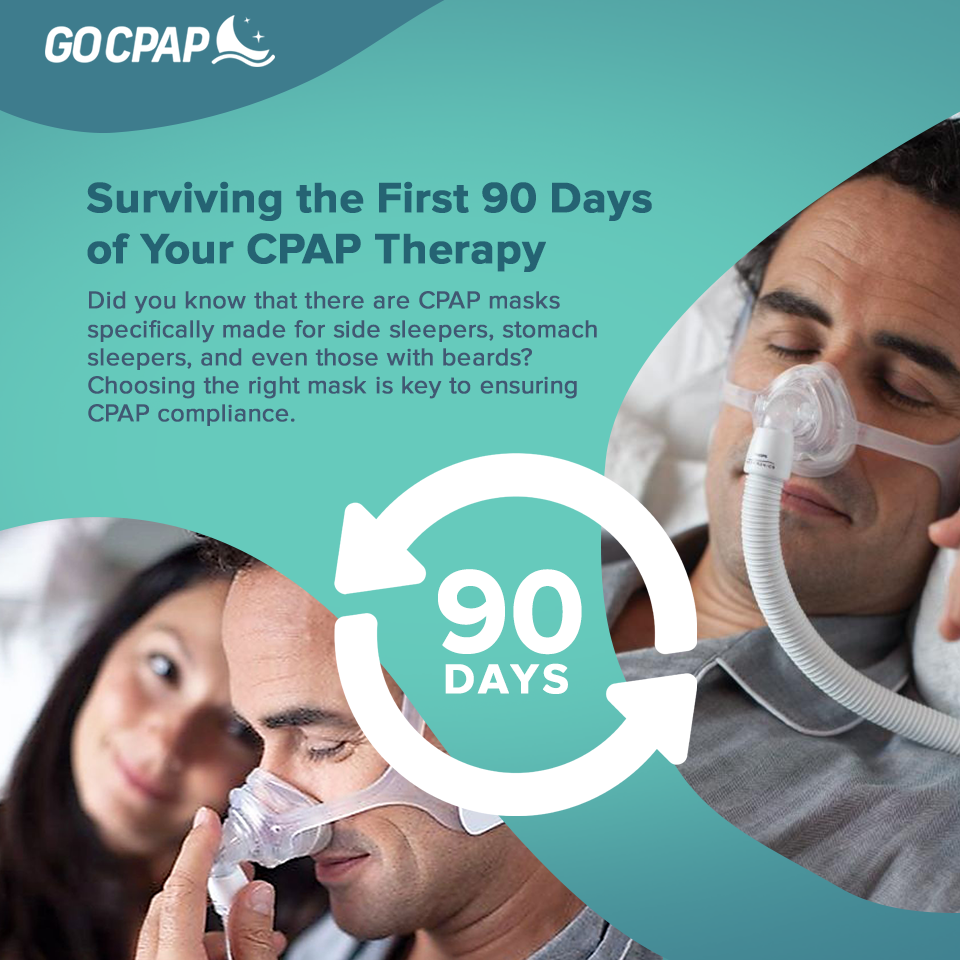Sep 14th 2020
How to Survive the First 90 Days of Your CPAP Therapy
How to Survive the First 90 Days of Your CPAP Therapy
For those who are starting their CPAP therapy, adjusting to a new routine will most likely be a challenge. CPAP therapy is the most effective treatment for sleep apnea but you have to be consistent and not miss a single night. Here’s how you can survive the first 90 days!
What is Obstructive Sleep Apnea?
Obstructive sleep apnea (OSA) is a debilitating and often life-threatening medical condition. It is the most common type of sleep apnea.
When a healthy person sleeps, the muscles of the upper part of the throat allow air to flow into the lungs. However, when a person with OSA falls asleep, these muscles are not able to keep the air passage open all the time. When the airway closes, breathing stops, oxygen levels fall, and sleep is disrupted in order to open the airway.
The disruption of sleep usually lasts only a few seconds. However, these brief arousals interfere with sleep and prevent people with OSA from reaching the deep stages of sleep, such as rapid eye movement (REM) sleep, which the body needs in order to rest and replenish its strength. Once breathing is restored, people with OSA fall asleep only to repeat the cycle throughout the night.

Tip #1: Make sure to choose the right mask for you
Before choosing a CPAP mask, you must first familiarize yourself with its 3 main types: Nasal Pillow CPAP Mask, Nasal CPAP Mask, and Full Face CPAP Mask.
Nasal pillows are a good option for sleep apnea patients who want masks that have minimal contact on the face. One of the major differences between a nasal mask and a nasal pillow is that nasal masks deliver the airflow indirectly to your airway. On the other hand, a full face CPAP mask covers all of your nose and mouth. If you mostly breathe through your mouth, we highly suggest you browse through GoCPAP’s wide range of full face CPAP masks.
Read: 3 Main Types of CPAP Masks: How to Choose the Right CPAP Mask
Tip #2: Get used to wearing your mask
Once you have chosen the appropriate CPAP mask for you, make sure that you get used to wearing it. You can do this by wearing the mask even when you’re not sleeping. It’s going to be a challenge transitioning into your CPAP therapy but it is crucial not to miss a single night.
Tip #3: Make sure that your CPAP pressure is not too high or too low
The general rule is that your CPAP pressure should be prescribed by your doctor. It should be enough to keep your airways open and unobstructed for the entire night. Keep in mind that when your CPAP pressure is too low, you’re most likely to loudly snore or wake up gasping for air. On another note, if your CPAP pressure is too high, you’ll experience nasal congestion, interrupted sleep, and uncomfortable sleep therapy.
Read: How To Tell If Your CPAP Pressure Is Too High Or Too Low
Tip #4: Make sure to change your mask every 3 to 6 months
Quality sleep therapy comes from the use of proper CPAP equipment and its maintenance. A big part of that is replacing your equipment when the time comes. Your CPAP mask, for example, experiences wear and tear every night. Failure to replace your mask when needed would lead to numerous health complications and could even tamper the quality of your CPAP therapy.
Read: 5 Reasons Why You Must Change Your Mask Every 3 to 6 Months
Tip #5: Make sure to change your CPAP mask cushion every 1 to 3 months
While it may seem like a waste to replace a mask cushion that looks perfectly fine, it is crucial to understand that mask parts acquire oils and dirt from your skin every time you use it. Regular use can also soften it, allowing air to leak.
Luckily, GoCPAP offers a wide range of mask cushions that will meet your CPAP needs. Remember, mask cushions should be replaced every 1 to 3 months.











